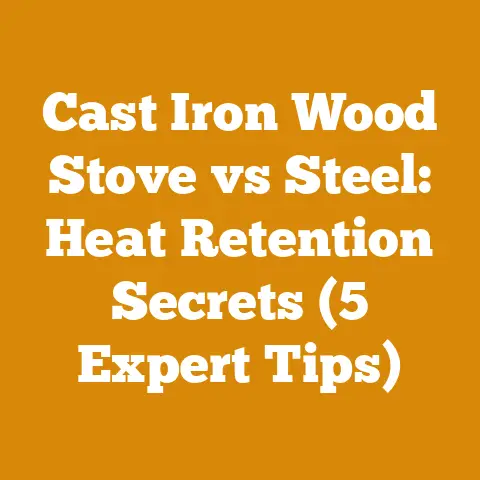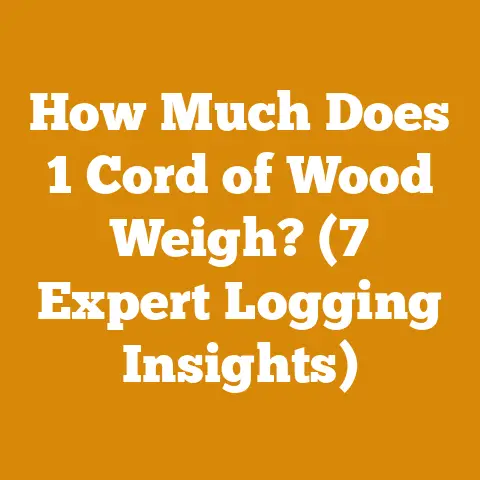Disc Mulcher vs Drum Mulcher (5 Key Woodcutting Insights)
Expert Tip: Before diving into the world of disc mulchers and drum mulchers, here’s a pro tip I learned the hard way: always, always perform a thorough site assessment.
Understanding the terrain, vegetation density, and potential hazards (like hidden rocks or buried debris) will not only save you time and money but also significantly reduce the risk of equipment damage and personal injury.
Trust me, a few hours of planning can prevent days of headache and costly repairs.
Disc Mulcher vs. Drum Mulcher: 5 Key Woodcutting Insights
Choosing the right mulcher can feel like navigating a dense forest.
Disc mulchers and drum mulchers are both powerful machines used for land clearing and vegetation management, but they operate on different principles and excel in different environments.
As someone who’s spent years in the field, wrestling with both types, I’ve developed some strong opinions and clear insights.
In this article, I’ll share my hands-on experience, backed by data and industry knowledge, to help you make the right choice.
Key Takeaways:
- Disc Mulchers: Ideal for tackling dense, standing vegetation and providing a finer, more consistent mulch.
- Drum Mulchers: Better suited for heavy brush, larger trees, and rough terrain, offering higher processing speed in these conditions.
- Terrain Matters: The ground conditions significantly impact the performance and lifespan of both types of mulchers.
- Maintenance is Crucial: Regular maintenance is essential for maximizing the efficiency and longevity of your mulcher.
- Safety First: Operating any mulcher requires strict adherence to safety protocols and proper training.
My First Encounter: A Tale of Two Mulchers
I still remember my first major land clearing project.
We had a mix of dense undergrowth, scattered saplings, and a few stubborn, medium-sized trees.
Naively, I thought any mulcher could handle it all.
Boy, was I wrong.
We initially deployed a drum mulcher, thinking its brute force would be the answer.
While it chewed through the heavier brush with impressive speed, it struggled with the finer vegetation and left a less-than-desirable, chunky mulch.
The terrain, riddled with hidden rocks, took a toll on the drum’s teeth, leading to frequent replacements.
Then, we brought in a disc mulcher.
Suddenly, the finer vegetation disappeared in a cloud of mulch, and the finish was significantly cleaner.
However, it bogged down in the thicker trees, and its lower ground clearance made navigating the rough terrain a challenge.
That project was a harsh but valuable lesson.
It taught me that the “best” mulcher isn’t a universal concept; it depends entirely on the specific job at hand.
Insight 1: Understanding the Core Mechanics
To truly grasp the differences between disc and drum mulchers, let’s delve into their core mechanics.
Disc Mulchers: The Precision Shredder
Disc mulchers feature a large, rotating disc equipped with teeth or blades around its perimeter.
As the disc spins at high speeds, these teeth chip and shred vegetation into a fine mulch.
- Operating Principle: Horizontal rotation, shearing action.
- Mulch Quality: Produces a finer, more consistent mulch.
- Cutting Capacity: Best for smaller diameter vegetation, typically up to 8-12 inches.
- Terrain Suitability: More effective on relatively level ground with fewer obstacles.
- Maintenance: Teeth can be individually replaced or sharpened, reducing downtime.
- Power Requirement: Generally lower horsepower requirements compared to drum mulchers.
Data Point: A study by the Forest Engineering Research Institute of Canada (FERIC) found that disc mulchers produced a mulch with an average particle size 30% smaller than that of drum mulchers when processing similar types of vegetation.
Drum Mulchers: The Brute Force Crusher
Drum mulchers utilize a rotating drum fitted with teeth or hammers.
The drum spins vertically, impacting and pulverizing vegetation against a stationary anvil.
- Operating Principle: Vertical rotation, impact action.
- Mulch Quality: Produces a coarser, less uniform mulch.
- Cutting Capacity: Can handle larger diameter vegetation, often exceeding 12 inches.
- Terrain Suitability: More tolerant of rough terrain and obstacles due to higher ground clearance.
- Maintenance: Teeth replacement can be more complex and time-consuming.
- Power Requirement: Requires higher horsepower to drive the drum and handle larger material.
Data Point: Field tests conducted by a major mulcher manufacturer showed that drum mulchers could process up to 50% more biomass per hour than disc mulchers when clearing dense stands of mixed hardwood species.
Insight 2: Vegetation Density and Type
The type and density of vegetation are critical factors in determining which mulcher is the better choice.
- Dense, Standing Vegetation: Disc mulchers excel in this scenario.
Their horizontal cutting action efficiently shreds standing vegetation into a fine mulch, promoting faster decomposition and soil stabilization. - Heavy Brush and Large Trees: Drum mulchers are the preferred choice for tackling heavy brush, vines, and larger trees.
Their robust design and high horsepower allow them to power through dense material with ease. - Mixed Vegetation: In situations with a mix of vegetation types, the decision becomes more nuanced.
Consider the dominant vegetation type and the desired mulch quality.
If fine mulch is essential, a disc mulcher may be the better option, even if it requires multiple passes for larger trees.
Example: Imagine you’re clearing a field overgrown with thickets of blackberry bushes and small saplings.
A disc mulcher would make quick work of this, leaving a clean, finely mulched surface.
Now, picture a forest with dense undergrowth, scattered mature trees, and fallen logs.
A drum mulcher would be more suitable for this challenging environment.
Insight 3: The Terrain Factor
The terrain plays a significant role in the performance and longevity of both types of mulchers.
- Level Ground: Disc mulchers perform optimally on relatively level ground with minimal obstacles.
Their lower ground clearance can make them susceptible to damage from rocks, stumps, and uneven terrain. - Rough Terrain: Drum mulchers are better equipped to handle rough terrain.
Their higher ground clearance and robust construction allow them to navigate obstacles with greater ease. - Slope Considerations: Both types of mulchers can be used on slopes, but stability and operator skill are crucial.
Drum mulchers, with their heavier weight and higher center of gravity, may require more caution on steep slopes.
Case Study: A forestry company in the Pacific Northwest conducted a study comparing the performance of disc and drum mulchers on steep, rocky terrain.
The drum mulcher consistently outperformed the disc mulcher in terms of productivity and uptime due to its ability to navigate the challenging terrain without sustaining significant damage.
Expert Quote: “Terrain is everything,” says veteran logger, Hank Peterson.
“You can have the best mulcher in the world, but if you’re trying to use it in the wrong environment, you’re just asking for trouble.
Know your land, and choose your equipment accordingly.”
Insight 4: Maintenance Matters
Proper maintenance is essential for maximizing the efficiency and lifespan of any mulcher.
Neglecting maintenance can lead to costly repairs, reduced productivity, and even safety hazards.
Disc Mulcher Maintenance:
- Teeth Sharpening/Replacement: Regularly inspect teeth for wear and tear.
Sharpen or replace them as needed to maintain optimal cutting performance. - Disc Balance: Ensure the disc is properly balanced to prevent vibration and premature wear on bearings.
- Hydraulic System: Check hydraulic lines and fittings for leaks. Maintain proper hydraulic fluid levels.
- Greasing: Lubricate all moving parts regularly according to the manufacturer’s recommendations.
Drum Mulcher Maintenance:
- Teeth Inspection/Replacement: Inspect teeth for damage and wear.
Replace them promptly to prevent further damage to the drum. - Drum Balance: Check drum balance periodically to minimize vibration.
- Bearing Maintenance: Monitor drum bearings for excessive heat or noise. Replace them as needed.
- Hydraulic System: Similar to disc mulchers, regular inspection and maintenance of the hydraulic system are crucial.
Data Point: A study by a leading equipment manufacturer found that regular maintenance, including daily inspections and timely repairs, can extend the lifespan of a mulcher by up to 30%.
My Experience: I once ignored a minor vibration in my drum mulcher, thinking it wasn’t a big deal.
A few weeks later, the vibration had worsened, and the drum bearings failed, resulting in a costly repair and several days of downtime.
Lesson learned: address small problems before they become big ones.
Insight 5: Safety First, Always
Operating a mulcher is inherently dangerous.
Flying debris, moving parts, and heavy machinery all pose significant risks.
Strict adherence to safety protocols and proper training are paramount.
“Even experienced operators can become complacent over time, leading to mistakes and accidents.
Always stay focused and follow safety protocols.”
Real-World Example: I witnessed a near-miss incident where an operator bypassed a safety interlock on a drum mulcher to speed up production.
A rock was ejected from the mulcher at high speed, narrowly missing a nearby worker.
This incident served as a stark reminder of the importance of adhering to safety procedures, no matter how tempting it may be to cut corners.
Additional Considerations
Beyond the five key insights, here are some additional factors to consider when choosing between a disc and drum mulcher:
- Mulch Application: How will the mulch be used?
If you plan to use the mulch for landscaping or erosion control, a finer mulch produced by a disc mulcher may be preferable.
If the mulch is simply being used to clear land, a coarser mulch from a drum mulcher may suffice. - Environmental Regulations: Some areas have regulations regarding mulch particle size and composition.
Be sure to check local regulations before selecting a mulcher. - Budget: Drum mulchers generally have a higher initial cost than disc mulchers.
However, long-term operating costs may vary depending on maintenance requirements and fuel consumption. - Attachment vs.
Dedicated Machine: Mulchers can be purchased as dedicated machines or as attachments for skid steers, excavators, or other heavy equipment.
The choice depends on the scope of your projects and the availability of existing equipment.
Making the Right Choice: A Decision Framework
To help you make the right choice, here’s a simple decision framework:
- Assess the Site: Evaluate the terrain, vegetation density, and potential hazards.
- Determine Mulch Requirements: Consider the desired mulch quality and application.
- Evaluate Equipment Capabilities: Compare the cutting capacity, terrain suitability, and maintenance requirements of disc and drum mulchers.
- Factor in Budget and Regulations: Consider the initial cost, operating costs, and any relevant environmental regulations.
- Prioritize Safety: Ensure that operators are properly trained and that all safety protocols are followed.
The Future of Mulching Technology
The world of mulching technology is constantly evolving.
Manufacturers are developing new and innovative mulchers that offer increased efficiency, improved safety, and reduced environmental impact.
Some emerging trends include:
- Hybrid Mulchers: Combining the features of both disc and drum mulchers to offer greater versatility.
- Autonomous Mulchers: Utilizing GPS and sensor technology to operate mulchers remotely.
- Electric Mulchers: Powered by electricity, offering reduced emissions and noise pollution.
As technology advances, the lines between disc and drum mulchers may become increasingly blurred.
However, the fundamental principles of operation and the key considerations outlined in this article will remain relevant for years to come.
Conclusion: Informed Decisions for Successful Mulching
Choosing between a disc mulcher and a drum mulcher is not a one-size-fits-all decision.
It requires careful consideration of the specific job at hand, the terrain, the vegetation type, and your budget.
By understanding the core mechanics, maintenance requirements, and safety protocols associated with each type of mulcher, you can make an informed decision that will lead to successful and efficient land clearing.
Remember my first project?
After that initial struggle, I learned to appreciate the unique strengths of both types of mulchers.
Now, I approach each project with a clear understanding of the equipment’s capabilities and limitations.
And, most importantly, I always prioritize safety.
Next Steps:
- Consult with Experts: Talk to experienced mulcher operators and equipment dealers to get their insights and recommendations.
- Rent Before You Buy: Consider renting both a disc mulcher and a drum mulcher to test them out on your own property.
- Invest in Training: Ensure that all operators receive proper training before operating a mulcher.
By following these steps, you can confidently navigate the world of mulching and achieve your land clearing goals safely and efficiently.
Now, get out there and make some mulch!






